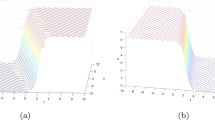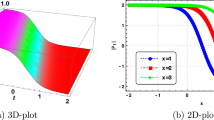Abstract
We analyze nonlinear Schrödinger and wave equations whose linear part is given by the renormalized Anderson Hamiltonian in two and three dimensional periodic domains.
Similar content being viewed by others
References
Agmon, S.: Lectures on elliptic boundary value problems. Prepared for publication by B. Frank Jones, Jr. with the Assistance of George W. Batten, Jr. Van Nostrand Mathematical Studies, No. 2. D. Van Nostrand Co., Inc., Princeton, N.J.-Toronto-London (1965)
Allez, R., Chouk, K.: The continuous Anderson Hamiltonian in dimension two (2015). arXiv:1511.02718 [math]
Babuška, I.: Error-bounds for finite element method. Numer. Math. 16(4), 322–333 (1971)
Bourgain, J.: Fourier transform restriction phenomena for certain lattice subsets and applications to nonlinear evolution equations. Geom. Funct. Anal. GAFA 3(2), 209–262 (1993)
Brezis, H., Gallouet, T.: Nonlinear Schrödinger evolution equations. Nonlinear Anal. Theory Methods Appl. 4(4), 677–681 (1980)
Burq, N., Gérard, P., Tzvetkov, N.: Strichartz inequalities and the nonlinear Schrödinger equation on compact manifolds. Am. J. Math. 126(3), 569–605 (2004)
Cannizzaro, G., Chouk, K.: Multidimensional SDEs with singular drift and universal construction of the polymer measure with white noise potential (2015). ArXiv preprint arXiv:1501.04751
Cazenave, T.: Semilinear Schrödinger Equations. American Mathematical Soc, Providence (2003)
Debussche, A., Weber, H.: The Schrödinger equation with spatial white noise potential (2016). ArXiv preprint arXiv:1612.02230
Dragomir, S.S.: Some Gronwall Type Inequalities and Applications. Nova Science Publishers, Inc., Hauppauge (2003)
Evans, L.C.: Partial Differential Equations, Volume 19 of Graduate Studies in Mathematics, 2nd edn. American Mathematical Society, Providence (2010)
Gubinelli, M., Koch, H., Oh, T.: Renormalization of the two-dimensional stochastic nonlinear wave equation (2017). arXiv:1703.05461 [math]
Gubinelli, M., Perkowski, N.: An introduction to singular SPDEs. ArXiv e-prints (2017)
Gubinelli, M., Imkeller, P., Perkowski, N.: Paracontrolled distributions and singular PDEs. In: Forum of Mathematics, Pi, vol. 3. Cambridge University Press (2015)
Gubinelli, M., Perkowski, N.: KPZ reloaded. Commun. Math. Phys. 349(1), 165–269 (2017)
Hairer, M.: A theory of regularity structures. Invent. Math. 198(2), 269–504 (2014)
Hairer, M., Labbé, C.: A simple construction of the continuum parabolic Anderson model on \({\bf R}^2\). Electron. Commun. Probab. 20(43), 11 (2015)
Labbé, C.: The continuous Anderson hamiltonian in \(d\le 3\) (2018). arXiv:1809.03718
Reed, M., Simon, B.: Methods of Modern Mathematical Physics. I. Functional Analysis. Academic Press, New York (1972)
Reed, M., Simon, B.: Methods of Modern Mathematical Physics. II. Fourier Analysis, Self-Adjointness. Academic Press Harcourt Brace Jovanovich, Publishers, New York (1975)
Tao, T.: Nonlinear Dispersive Equations: Local and Global Analysis, vol. 106. American Mathematical Soc, Providence (2006)
Acknowledgements
We gratefully acknowledge partial support from the German Research Foundation (DFG) via CRC 1060.
Author information
Authors and Affiliations
Corresponding author
Additional information
Publisher's Note
Springer Nature remains neutral with regard to jurisdictional claims in published maps and institutional affiliations.
Paracontrolled distributions and function spaces
Paracontrolled distributions and function spaces
We recall the definitions of Bony paraproducts, Besov and Sobolev spaces and collect some results about products of distributions. We work on the d-dimensional torus \(\mathbb {T}^d:= \mathbb {R}^d/\mathbb {Z}^d\) for \(d=2,3\). For any f in the space \(\mathscr {S}' ( \mathbb T^d,\mathbb R)\) of tempered distributions on \(\mathbb {T}^d\), the Fourier transform of f will be denoted by \(\hat{f} : \mathbb {Z}^d\rightarrow \mathbb {C}\) (or sometimes \(\mathscr {F}f\)) and is defined for \(k\in \mathbb {Z}^d\) by
Recall that for any \(f\in L^2(\mathbb {T}^d,\mathbb {R})\) and a.e. \(x\in \mathbb {T}^d\), we have
The Sobolev space \(\mathscr {H}^\alpha (\mathbb T^d)\) with index \(\alpha \in \mathbb {R}\) is defined as
Before introducing the Besov spaces, we recall the definition of Littlewood-Paley blocks. We denote by \(\chi \) and \(\rho \) two nonnegative smooth and compactly supported radial functions \(\mathbb {R}^d\rightarrow \mathbb {R}\) such that
- 1.
The support of \(\chi \) is contained in a ball \(\{x\in \mathbb {R}^d: |x| \le R\}\) and the support of \(\rho \) is contained in an annulus \(\{x\in \mathbb {R}^d: a\le |x| \le b\}\);
- 2.
For all \(\xi \in \mathbb {R}^d\), \(\chi (\xi )+\sum _{j\ge 0}\rho (2^{-j}\xi )=1\);
- 3.
For \(j\ge 1\), \(\chi \rho (2^{-j}\cdot )\equiv 0\) and \(\rho (2^{-i}\cdot ) \rho (2^{-j}\cdot )\equiv 0\) for \(|i-j|\ge 1\).
The Littlewood-Paley blocks \((\Delta _j)_{j\ge -1}\) acting on \(f\in \mathscr {S}'(\mathbb {T}^d)\) are defined by
Note that, for \(f\in \mathscr {S}'(\mathbb {T}^d)\), the Littlewood-Paley blocks \((\Delta _j f)_{j\ge -1}\) define smooth functions, as their Fourier transforms have compact supports. We also set, for \(f\in \mathscr {S}'\) and \(j\ge 0\),
and note that \(S_j f\) converges in the sense of distributions to f as \(j\rightarrow \infty \).
The Besov space with parameters \(p,q \in [1,\infty ),\alpha \in \mathbb {R}\) can now be defined as
We also define the Besov-Hölder spaces
which are naturally equipped with the norm \(\Vert f\Vert _{\mathscr {C}^\alpha }:=\Vert f\Vert _{B_{\infty ,\infty }^{\alpha }}=\sup _{j\ge -1} 2^{j \alpha } \Vert \Delta _j f\Vert _{L^\infty }\). For \(\alpha \in (0,1)\) these spaces coincide with the classical Hölder spaces.
We can formally decompose the product fg of two distributions f and g as
where
are usually referred to as the paraproducts whereas
is called the resonant product.
Moreover, we define the notations \(f\preccurlyeq g:=f\prec g+f\circ g\) and \(f\succcurlyeq g:=f\succ g+f\circ g\).
The paraproduct terms are always well defined irrespective of regularities. The resonant product is a priori only well defined if the sum of regularities is strictly greater than zero. This is reminiscent of the well known fact that one can not multiply distributions in general. The following result makes those comments precise and gives simple but extremely vital estimates for paraproducts.
Proposition A.1
(Bony estimates,[2]) Let \(\alpha , \beta \in \mathbb {R}\). We have the following bounds:
- 1.
If \(f \in L^2\) and \(g \in \mathscr {C}^{\beta }\), then
$$\begin{aligned} \Vert f \prec g \Vert _{\mathscr {H}^{\beta - \delta }} \le C_{\delta , \beta } \Vert f \Vert _{L^2} \Vert g \Vert _{\mathscr {C}^{\beta }} \end{aligned}$$for all \(\delta > 0\).
- 2.
if \(f \in \mathscr {H}^{\alpha }\) and \(g \in L^{\infty }\) then
$$\begin{aligned} \Vert f \succ g \Vert _{\mathscr {H}^{\alpha }} \le C_{\alpha , \beta } \Vert f \Vert _{\mathscr {H}^{\alpha }} \Vert g \Vert _{\mathscr {C}^{\beta }}. \end{aligned}$$ - 3.
If \(\alpha < 0\), \(f \in \mathscr {H}^{\alpha }\) and \(g \in \mathscr {C}^{\beta }\), then
$$\begin{aligned} \Vert f \prec g \Vert _{\mathscr {H}^{\alpha + \beta }} \le C_{\alpha , \beta } \Vert f \Vert _{\mathscr {H}^{\alpha }} \Vert g \Vert _{\mathscr {C}^{\beta }}. \end{aligned}$$ - 4.
If \(g \in \mathscr {C}^{\beta }\) and \(f \in \mathscr {H}^{\alpha }\) for \(\beta < 0\) then
$$\begin{aligned} \Vert f \succ g\Vert _{\mathscr {H}^{\alpha + \beta }} \le C_{\alpha , \beta } \Vert f \Vert _{\mathscr {H}^{\alpha }} \Vert g \Vert _{\mathscr {C}^{\beta }} \end{aligned}$$ - 5.
If \(\alpha + \beta > 0\) and \(f \in \mathscr {H}^{\alpha }\) and \(g \in \mathscr {C}^{\beta }\), then
$$\begin{aligned} | | f \circ g \Vert _{\mathscr {H}^{\alpha + \beta }} \le C_{\alpha , \beta } \Vert f \Vert _{\mathscr {H}^{\alpha }} \Vert g \Vert _{\mathscr {C}^{\beta }}. \end{aligned}$$
where \(C_{\alpha , \beta }\) is a finite positive constant.
Proposition A.2
Given \(\alpha \in (0, 1)\), \(\beta , \gamma \in \mathbb {R}\) such that \(\beta + \gamma < 0\) and \(\alpha + \beta + \gamma > 0\), there exists a trilinear operator C with the following bound
for all \(f \in \mathscr {H}^{\alpha }\), \(g \in \mathscr {C}^{\beta }\) and \(h \in \mathscr {C}^{\gamma }\).
The restriction of C to the smooth functions satisfies
Proof
This is a restatement of the result (commutator Lemma) in [2], and the proof follows the same lines, with slight modifications. \(\square \)
We also prove the following modified version of the above Proposition, which suits our framework.
Proposition A.3
Let \(\alpha \in (0, 1)\), \(\beta , \gamma \in \mathbb {R}\) such that \(\beta + \gamma < 0\) and \(\alpha + \beta + \gamma > 0\). Then, there exists a trilinear operator \(C_N\) with the following bound
for all \(f \in \mathscr {H}^{\alpha }\), \(g \in \mathscr {C}^{\beta }\) and \(h \in \mathscr {C}^{\gamma }\).
The restriction of \(C_N\) to the smooth functions satisfies
Proof
Observe that we have
So, we only need to show
By product estimates, we obtain right away
We need to show
We can write
By the support of Fourier transforms we have that \( \Delta _k \left( \Delta _{\le N} (f\prec g)\right) ) = 0\) for \(k> N+1\) so we obtain
By using the convention \(\Delta _{<k} f:= \sum _{i=-1}^{k-2} \Delta _k f\) we rewrite
Again by support arguments this boils down to
Applying two successive Young’s we obtain
where on the right hand side we can write
At this point, it is clear that for a constant depending on N we readily have
and the result follows.
Lemma A.4
(Bernstein’s inequality, [14]) Let \(\mathscr {A}\) be an annulus and \(\mathscr {B}\) be a ball. For any \(k \in \mathbbm {N}, \lambda > 0,\)and \(1 \le p \le q \le \infty \) we have
- 1.
if \(u \in L^p (\mathbbm {R}^d) \) is such that \({\text {supp}} (\mathscr {F}u) \subset \lambda \mathscr {B}\) then
$$\begin{aligned} \underset{\mu \in \mathbbm {N}^d : | \mu | = k}{\max } \Vert \partial ^{\mu } u \Vert _{L^q} \lesssim _k \lambda ^{k + d \left( \frac{1}{p} - \frac{1}{q} \right) } \Vert u \Vert _{L^p} \end{aligned}$$ - 2.
if \(u \in L^p (\mathbbm {R}^d) \)is such that \({\text {supp}} (\mathscr {F}u) \subset \lambda \mathscr {A}\) then
$$\begin{aligned} \lambda ^k \Vert u \Vert _{L^p} \lesssim _k \underset{\mu \in \mathbbm {N}^d : | \mu | = k}{\max } \Vert \partial ^{\mu } u \Vert _{L^p}. \end{aligned}$$
Proposition A.5
(Paralinearisation, [15]) Let \(\alpha \in (0, 1) \) and \(F \in C^2 .\) Then there exists a locally bounded map \(R_F : \mathscr {C}^{\alpha } \rightarrow \mathscr {C}^{2 \alpha }\) such that
Lemma A.6
Let \(\alpha , \beta , \gamma \in \mathbbm {R}\) with \(\alpha + \beta <0\), \(\alpha + \beta + \gamma \ge 0\), and \(f \in \mathscr {H}^{\alpha }, g \in \mathscr {C}^{\beta }, h \in \mathscr {H}^{\gamma },\) then there exists a map D(f, g, h) with the following bound
Moreover the restriction of D(f, g, h) to the smooth functions f, g, h is as follows:
Proof
We define
So we get, for some \(\delta >0\),
and this argument can be adapted to show (69) by simply observing \(1 \le 2^{k(\beta + \alpha + \gamma )} = 2^{k\beta }2^{k ( \alpha + \gamma )} \), since \(\beta + \alpha + \gamma \ge 0\) . Moreover, for smooth functions f, g, h; we can compute
Hence the result. \(\square \)
Remark A.7
Proposition A.6 says that the paraproduct is almost the adjoint of the resonant product, meaning up to a more regular remainder term as is often the case in paradifferential calculus.
Lemma A.8
Let \(f \in \mathscr {H}^{\alpha }, g \in \mathscr {C}^{\beta },\) with \(\alpha \in (0, 1), \beta \in \mathbbm {R},\) there exists a bilinear map R(f, g) that satisfies the following bound
and restricts to smooth functions as
Proof
The proof is basically a straightforward modification of the proof of [2, Proposition A.2], which has almost the same statement. \(\square \)
Rights and permissions
About this article
Cite this article
Gubinelli, M., Ugurcan, B. & Zachhuber, I. Semilinear evolution equations for the Anderson Hamiltonian in two and three dimensions. Stoch PDE: Anal Comp 8, 82–149 (2020). https://doi.org/10.1007/s40072-019-00143-9
Received:
Revised:
Published:
Issue Date:
DOI: https://doi.org/10.1007/s40072-019-00143-9




